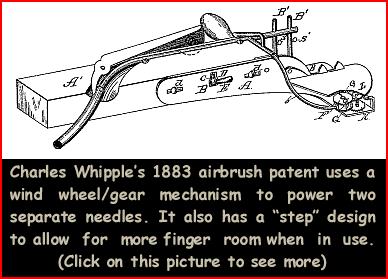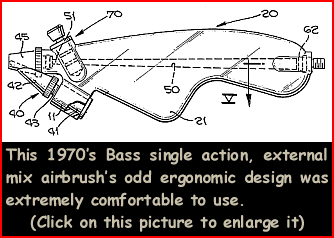|
Peeler
And Walkup weren't the only ones working to improve the airbrush
in the early and mid 1880's. John Whipple of Wisconsin was granted
a patent on July 3, 1883 for improvements to Peeler's original
design. His wind-wheel was made from two disks with the
vanes sandwiched between them, similar to a water wheel,
whereas Peeler's was a simple disk with the vanes formed by
bending part of the disk downward, like a pinwheel. Whipple also
has a novel, thinner needle assembly that looks like a square bow,
as in bow and arrow. The needle can be much thinner which allows
for a finer line. He is granted two more patents in November, 1883
 and January, 1884. The first patent uses a small gear on the
wind-wheel to drive a larger gear. It is a twin needle design as
both the wind-wheel and the large gear have needles and there are
two air blast tubes to operate them. The paint troughs are bent up
so that, according to Whipple, they retain paint when the
"distributer" is used in a vertical position. It also
has a "step" design in that the handle is elevated from
the "mechanics" to allow hand room when using the
airbrush. In this patent he is refuting the walking bar concept.
The second patent makes a 180 degree turn and incorporates the
walking bar. The patent shows both a single and a dual needle
version. The two needle design uses his bow needle as well as a
tapered one. The design has two other features, a guide to support
the needle at both ends and separate thumb and finger operated
triggers to adjust the air and the needle(s) during use. Two of
Whipple's innovations, the wind-wheel design and the needle guide
were later used by Walkup. Poor Mr. Whipple's two best ideas, the
finger operated needle adjustment , allowing for easier and single
hand operation and the needle guide were a day late and a dollar
short. Two months prior to his filing, Walkup had filed for a
similar idea that used a single trigger.
and January, 1884. The first patent uses a small gear on the
wind-wheel to drive a larger gear. It is a twin needle design as
both the wind-wheel and the large gear have needles and there are
two air blast tubes to operate them. The paint troughs are bent up
so that, according to Whipple, they retain paint when the
"distributer" is used in a vertical position. It also
has a "step" design in that the handle is elevated from
the "mechanics" to allow hand room when using the
airbrush. In this patent he is refuting the walking bar concept.
The second patent makes a 180 degree turn and incorporates the
walking bar. The patent shows both a single and a dual needle
version. The two needle design uses his bow needle as well as a
tapered one. The design has two other features, a guide to support
the needle at both ends and separate thumb and finger operated
triggers to adjust the air and the needle(s) during use. Two of
Whipple's innovations, the wind-wheel design and the needle guide
were later used by Walkup. Poor Mr. Whipple's two best ideas, the
finger operated needle adjustment , allowing for easier and single
hand operation and the needle guide were a day late and a dollar
short. Two months prior to his filing, Walkup had filed for a
similar idea that used a single trigger.
Every once in a while an airbrush pops up that is really nice and
doesn't catch on. Unfortunately, the Bass is one of those
airbrushes. It was made in the late
 1970's and early 1980's in Northridge, California, a suburb of Los
Angeles by Donald Bass. The handle is made of nylon and is very
comfortable and easy to use. Itís a basic single action,
external mix airbrush and it will accept the same cups or bottles
as a Paasche H or Badger 350. The major differences are the
3/8" thick white nylon body's funny ergonomic shape, the
trigger mounted farther forward than usual, and the air inlet at
the rear. These combine to give it a balance and feel that are
exceptional. It's too bad that wasn't successful because it's a
high quality airbrush and is far more comfortable to use than a
similar Paasche or Badger. A lack of advertising doomed it the
marketplace.
1970's and early 1980's in Northridge, California, a suburb of Los
Angeles by Donald Bass. The handle is made of nylon and is very
comfortable and easy to use. Itís a basic single action,
external mix airbrush and it will accept the same cups or bottles
as a Paasche H or Badger 350. The major differences are the
3/8" thick white nylon body's funny ergonomic shape, the
trigger mounted farther forward than usual, and the air inlet at
the rear. These combine to give it a balance and feel that are
exceptional. It's too bad that wasn't successful because it's a
high quality airbrush and is far more comfortable to use than a
similar Paasche or Badger. A lack of advertising doomed it the
marketplace.
|

